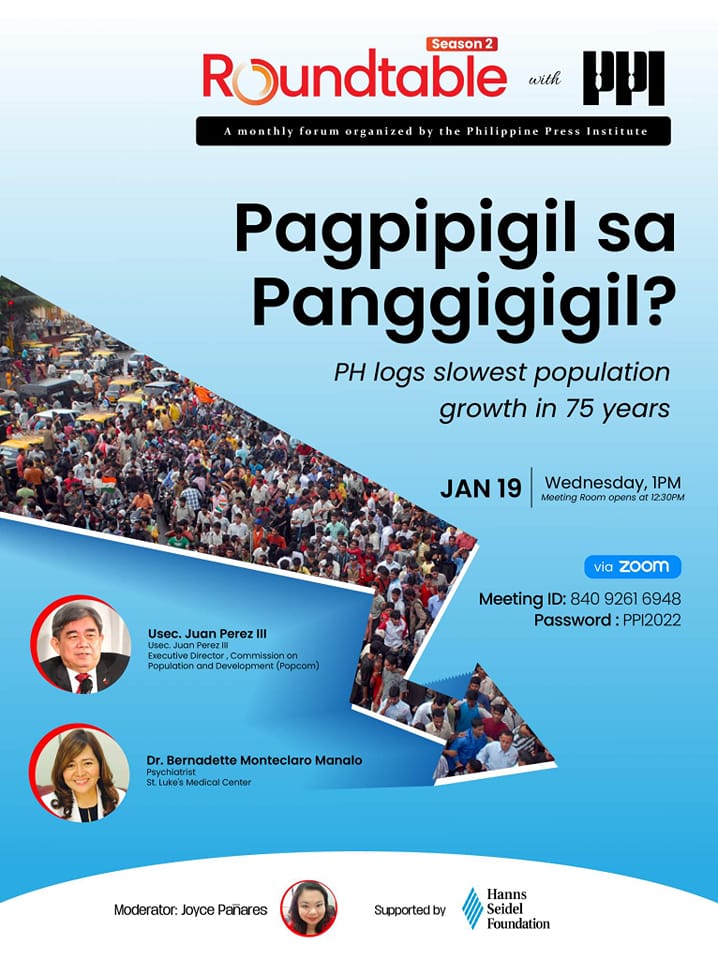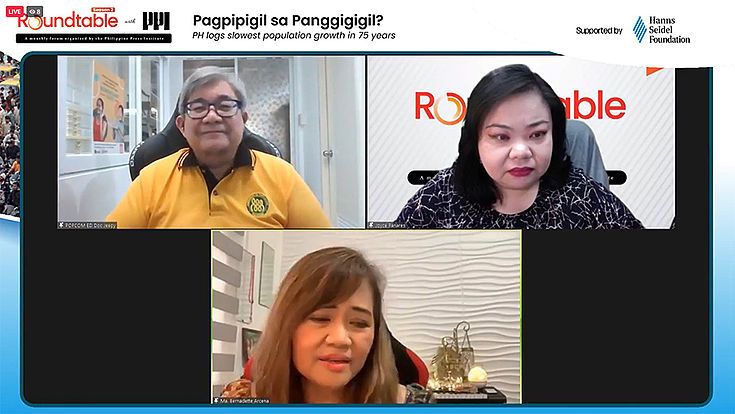Bringing Social Concerns to Light
Experts analyse the Philippine’s declining population growth rate in RTD
Philippine Press Institute; PPI
What are the reasons behind the Philippines’ lowest population growth rate since 1947? Why does it matter? A roundtable discussion held online on 19 January 2022 sought to take up these questions, identify possible antecedents and examine what consequences the country may end up having to deal with in the longer term. Media practitioners from Metro Manila and from the regions examine the situation with experts from the government and in private practice to gain insights from available data and exchange views and information.
The Commission on Population (POPCOM) saw a markedly lower population growth rate for the Philippines in 2021 at 0.3% compared with 2020’s figure, with the increase in the total number of Filipinos for the year projected to be between three to four hundred thousand. This was said to be comparable to the growth rate in 1946-1947. This projected number is said to represent the country’s “natural increase,” which is derived by deducting the figure for total number of deaths during the designated period from that of the total number of births.
Underlying causes for the country’s low growth were traced to women’s preference for planned pregnancies, issues of domestic violence and the lack of access to family planning and health services in general. Aside from the economic and financial aspects, mental well-being was also noted to have been adversely affected by the pandemic. The finite financial resources, restricted mobility and limited or lack of access to health care in the midst of different quarantine levels contributed to the creation of an environment that increased, along with the anxiety and level of stress of the people, the chances for marital conflict and domestic violence, including a subsequent underreporting thereof. Births, on the other hand, were noted to have been reported late.
HSF
Created through the enactment of Republic Act No. 6365 (Population Act of the Philippines) on 16 August 1971, the Commission on Population (POPCOM) was “mandated to serve as the central coordinating and policy making body of the government in the field of population.” It is said to comprise designated Cabinet members, heads of other government agencies as well as a representative from each of six civil society organizations across various sectors, and amongst which the Philippine Press Institute is named. Usec. Perez clarified that through the Responsible Parenthood and Family Planning (RP-FP) Program, POPCOM is “helping people attain their aspirations to have smaller families” based on the belief that family size is a matter of individual choice. Participation in the program is voluntary.
In conclusion, it was noted that the economic and psychosocial environment wrought by the ongoing health situation since 2020 played a considerable role in the lower population growth rate. It is foreseen that the situation will continue beyond the pandemic because of the economic crisis, for which a far longer recovery period is expected. While the country’s population growth rate has been declining in the past decades, the projection is that the annual number of births will stabilise at around one million or less births. Usec. Perez observed that, provided it does not run into negative figures, people’s preference for smaller families “will lead to a demographic transition that will lead to greater economic benefits in the population within the next five years.”
This activity is the maiden session of Season 2 of the “Roundtable with PPI” series, which debuted in June 2020. Streamed live online, it had 1,185 unique live viewers, aside from thirty-eight logged-in participants. Scheduled to be held every third Wednesday of the month, the series tackles current issues deemed to be of pressing concern to the public. This series is organised by the Philippine Press Institute (PPI) with support from the Hanns Seidel Foundation (HSF) as part of their project cooperation on civic journalism.


